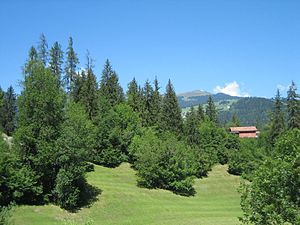Castrisch Castle
| Castrisch Castle | ||
|---|---|---|
|
Castrisch Castle Hill, view from the southeast |
||
| Creation time : | around 1100 | |
| Castle type : | Hilltop castle | |
| Conservation status: | Ruin, rubble | |
| Standing position : | Freelance | |
| Construction: | Rubble stones | |
| Place: | Castrisch | |
| Geographical location | 46 ° 46 '35 " N , 9 ° 14' 28" E | |
| Height: | 820 m above sea level M. | |
|
|
||
The castle Castrisch is the ruins of a hilltop castle in Castrisch (municipality Ilanz / Glion ) in the Swiss canton of Grisons .
location
The sparse ruins of the former castle of Castrisch are in the east of the village a little higher at 820 m above sea level. M. on an elongated rock spur above the road from Castrisch to Valendas . They can be easily reached via a narrow driveway. The place name Castrisch (from castrum "castle") and the field name Casti right next to the ruins still reminds of the castle .
investment
There are still two parts to be distinguished. From a higher tract in the west there are only isolated remnants of a wall running parallel, which could be the remains of a ring or a kennel . Various buildings seem to have stood within these walls, but nothing can be seen of them. Today a forest road runs through the ditch in the far west.
The eastern, lower part was surrounded by a wall following the edge of the terrain. Around the center of the plateau are the still recognizable ruins of a church dedicated to St. Michael with a floor plan of around 14 by 7 meters, the interior of which is heavily overgrown and filled with rubble. In the far east, where a thick fragment of the wall (no longer visible) indicated a tower, there is now the hut of a rifle club. In the north-east corner human bones from the former cemetery were found during wild excavations.
history
There are no written documents about the origins of the castle as such, but land in Castrice is already mentioned in Tello's will . In the Reichsguturbar of 842, the village church and the tithe of Castrisch appear as imperial property , which points to an early medieval church fort that was later expanded into a feudal castle.
The noble free von Castrisch appear in the so-called Gamertinger documents from 1137, Hugo et Heinricus de Castrisis are mentioned . They are thus one of the earliest attested aristocratic families in Raetia . This suggests the existence of a feudal castle that already existed then and was perhaps built in the 10th century.
The origin of the no longer noble lords of Castrisch, who appeared in the 13th century, can no longer be identified; her name only seems to be derived from her place of residence. In the 14th century the castle of Castrisch appears as the property of the Lords of Belmont . Adelheid von Montalt b. Belmont documented in 1371: the present is on the vesti ze Caestris .
After the death of the last Belmonter Ulrich Walter on July 11, 1371, Ulrich Brun bought the liens on the burg ze Caestris from the widow Floribella von Sax . In 1380 he exchanged his claims against those at the castle of Domat / Ems with Elisabeth von Sax-Rhäzüns. In 1390 Elisabeth ceded her rights to the village and fortress Castrisch to the Bishop of Chur , but received them back as a fief . In 1410 the castle appears in the Bouch der Vestinen: Item die vesti Caestris uff muntinen is och lehen vom Gotzhus .
The Sax-Misox decreed that after their extinction the people of the house of God were allowed to go to the castle Kästris and to the castle and rule . In 1483, Peter von Sax-Misox's Church Association bought the Belmont and Castrisch lords. In Ulrich Campell's time around 1550, the castle was already in ruins.
gallery
Web links
literature
- Otto P. Clavadetscher, Werner Meyer : The castle book of Graubünden . Zurich 1984, ISBN 3-280-01319-4





